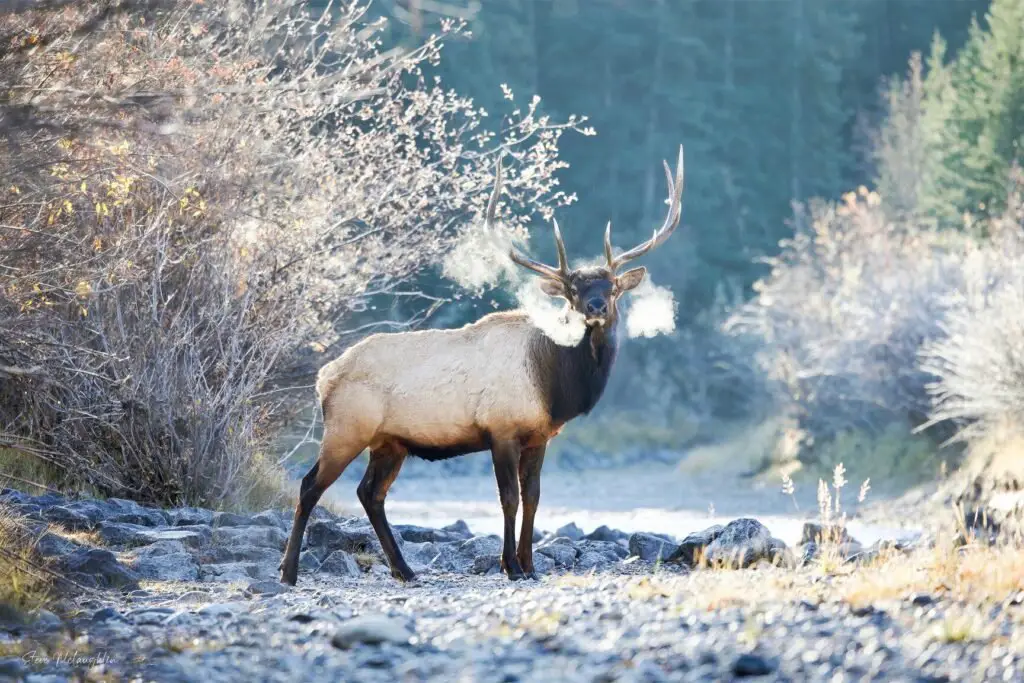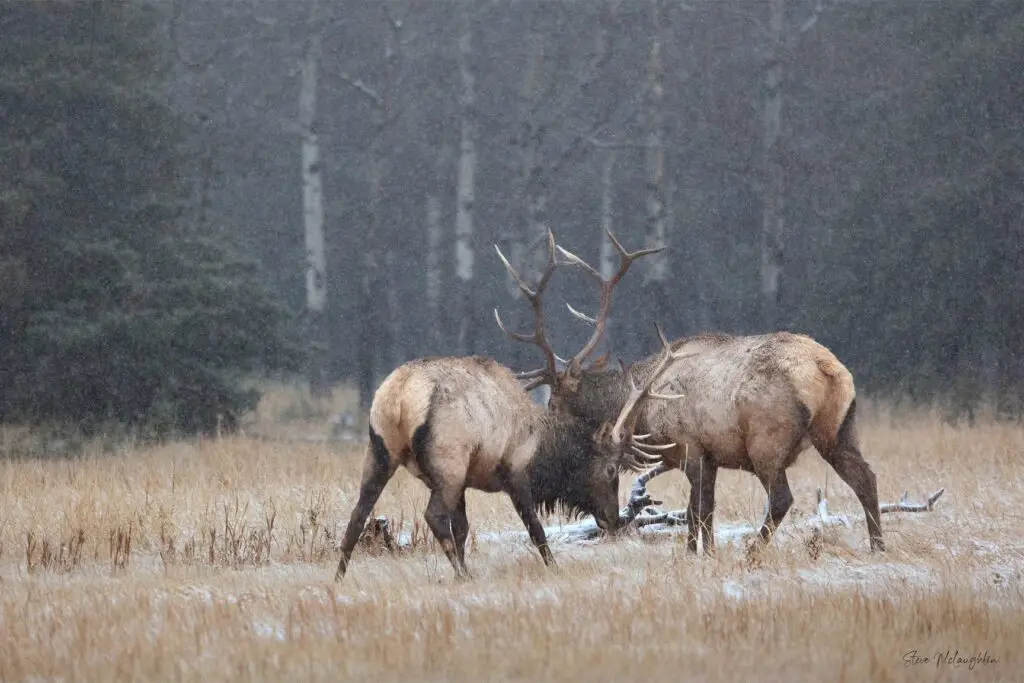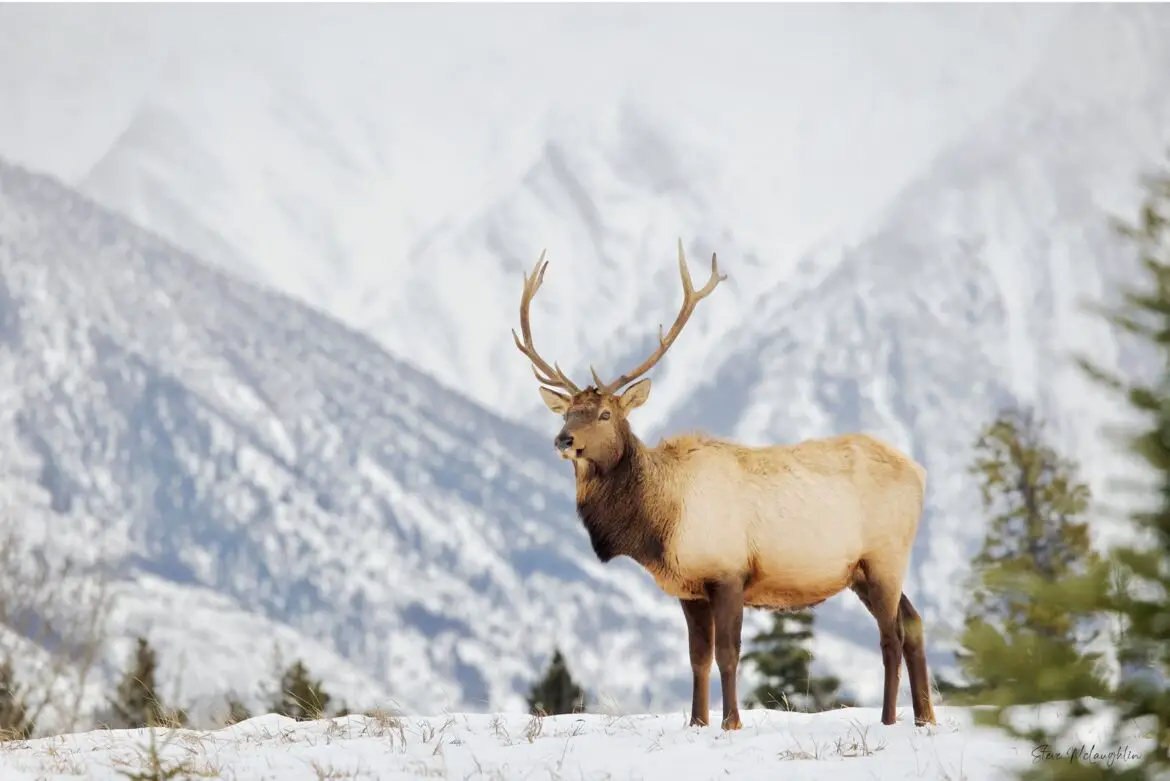If you’re traveling through the Canadian Rocky Mountains, you have great odds of seeing and photographing elk. These large animals are common throughout the Rockies – particularly Banff, Jasper National Park, and Banff’s neighboring town Canmore. They can even be spotted in Calgary, but definitely seem to prefer their home in the mountains.
Elk are large ungulates, in the same family as deer and moose. They’re also known by their Shawnee name, Wapiti (meaning “white rump”.) These impressive and graceful animals are a pleasure to spot on any trip to the Rockies, and even more so to photograph.
Table of Contents
Where to Find Elk in the Rockies
It’s pretty common to see elk along the sides of the Highway and even in town when you’re travelling through the Rockies. Elk seem to feel safe from predators like wolves and bears when they stay close to town. Look for them in valleys and open fields, as they are grazers.
Where to See Elk in Banff
Elk like to hang out all around the Town of Banff. Some popular elk spotting locations around Banff include:
- Banff Springs Golf Course – this is a very popular spot for herds of elk to hang around, especially during the rutting season.
- Vermillion Lakes – another longtime favourite for herds of elk.
- You can even find elk in Banff’s central park when it’s not busy.
- Tunnel Mountain Campground is another place the elk like to hang around. If you don’t see them, often in the fall you can hear them bugling in the valley below from this vantage point.
- Near the Bow River
Where to See Elk in Canmore
Canmore is just outside Banff National Park, and about a 20 minute drive from the Town of Banff. It might be worth it to take a drive out to Canmore if you don’t have any luck seeing elk in Banff. It’s also a charming little town with a bit of a different feel than Banff, and equally beautiful mountain ranges.

“Bull Elk in the Early Morning” from Canadian wildlife photographer Steve McLaughlin.
- Spray Lakes Road is one of the most well known spots for seeing all kinds of wildlife, including elk.
- Quarry Lake
- Moose Meadows
- Silvertip Golf Course
- Anywhere along the Bow River
Where to See Elk in Jasper
In our experience, elk are even more common around the townsite of Jasper than Banff. More often than not, when you drive through Jasper you can see them hanging around even on the side of the highway!
- Wapiti Campground
- Whistler’s Campground
- Near Patricia and Pyramid Lake – the road to these locations often has lots of elk
- Near the Fairmont Jasper Park Lodge – this hotel has large, sprawling grounds that elk like to hang out at
- East of the townsite (heading towards Hinton)
Best Times of Year to Photograph Elk
The time of year you visit the Parks makes a big difference in the photos you can get. I love to do elk photography in the fall, summer and winter when they are well fed and active. Certain times of year, like the late winter and spring time, the elk don’t look their best. The males lose their antlers and their fur looks scraggly as they shed their winter coats.
My Favourite Time to Photograph Elk: The Fall (September to October)
Rutting season for elk takes place between September and October. During this time you can hear their high-pitched whistles echo through the valleys, and watch the males sparring for female attention.
The elk are in great physical condition after feeding on grass all summer, and their coats are healthy and full. Of course, the bull elk show off their most impressive antlers and interesting behaviours during this season.

It’s also one of the most important times to give these large animals their space!
Prints of this image, “Battling Elk” by wildlife photographer Steve McLaughlin can be found in our print shop.
Photographing Elk in the Winter (November to January)
The winter can be a good time to photograph elk if you don’t mind the cold weather. The elk have nice thick winter coats and have settled down after the rut to graze on whatever vegetation they can find. If you get lucky enough to find them with snow-capped mountains in the background, you can take beautiful wide landscape shots with herds of elk in the foreground.
The Bow Valley often has spells of warmer weather during the winter, but it can be tough to plan a trip around this. Just bundle up well and enjoy the sparkling winter wonderland!
My Least Favourite Time: Late Winter to Early Summer (Late January to May)
Bull elk start to lose their antlers from late January and this shedding process continues into March.
Both males and females also molt their winter coats in the spring time, and they look thin, patchy and rough. This is my least favorite time to photograph elk.
Calving season is from mid-May to June. Females are of course very protective over their calves, and often hiding away in thick underbrush where they can be difficult to safely find and photograph. Parks Canada will close down areas where cows and calves are trying to rest.
Summer Time (Mid-June to Mid-September)
Elk are quite majestic in the summer time too. You can still expect to get lots of good pictures if you visit one of the Parks during peak tourist season! Because the sun is so bright, you may want to get out during golden hour in the evening, or early in the morning to catch more flattering light. Cloudy days in the summer can lend to more flattering light to photograph elk in too.
Best Time of Day to See Elk
My personal favourite time to photograph elk is in the early morning and the evening, when these animals are most active. The lighting is a lot easier to work with during these times as well. Though you’ll see a few elk walking around in the daytime, most prefer to lay down in wooded areas at midday, especially when the weather is hot.
Tips for Photographing Elk
Positioning
Choose a good position and stay put. This helps the animals feel more at ease with you and behave more naturally than if you were moving around. The direction the elk are facing is obviously important – it’s not much fun going through 100 images of elk bums!
Consider which direction the sunlight is coming from. If the sun is behind your back, the elk will be well lit. If the sun is behind the elk, editing can be more challenging. But you could play around with interesting back lighting or even dramatic silhouettes around sunset.
Consider the background as well. If your background is interesting (for example, the mountains or the Bow River) you might want to try to get more of it in focus by bumping your aperture up to f/8 or f/16. You could try some wider shots that include the environment as well as the elk. If the background isn’t particularly interesting, you might want it to be more blurry with larger apertures like f/2.8.
Choose the Right Gear
A telephoto lens is always good to have on hand for wildlife photography – especially when it comes to animals like elk who don’t like people in their space. We recommend staying at least 25 meters away from elk, and further away during rutting season (September to October) and calving season (May to June).
We use a 100-500mm lens on our camera 90% of the time, with a 70-300mm backup. This serves us well for all wildlife photography and can create intimate portraits without actually being too close.
Using a long lens also makes for beautiful background blur, with the subject sharply in focus. The eyes are the most critical part to get in focus. We use Canon R6 cameras especially for the animal eye recognition. For more tips on getting your shots in focus, check out our article:
Lighting
The lighting is constantly changing in the mountains, and you can spend a whole afternoon just watching the way the light and shadows dance across them! A window of 10 minutes can make all the difference between a good shot and a great one.
Thankfully, the lighting tends to be the best for wildlife photography in the morning and evening, when most animals – including elk – are most active. Photographing in the hot mid-day sun can be challenging, as the harsh shadows can be unflattering. Shaded areas can be your best friend when the sun is right overhead.
Don’t be afraid of shooting in inclement weather, like snowfall, fog, or on cloudy days. Changing weather conditions can make for even more dramatic and interesting shots.

Post Processing
Many of the elk in Banff and Jasper have identification tags on their ears and even wear tracking collars. You’ll have to decide if you want to use Photoshop to remove these tags in post processing, or just find animals that don’t have the tags.
Be Patient & Have Fun!
Take your time observing the elk. You can easily spend a few hours watching them to see what interesting behaviours pop up, especially if you are watching an entire herd.
Elk Safety
Surprisingly, elk display aggressive behaviour towards people more often than grizzly bears do in any given year. This could be because it’s more common to see elk, or because we assume they aren’t a threat and get too close.
Elk can attack with their sharp hooves and large antlers. They have even been known to charge vehicles in Jasper National Park. If a bull elk can do this much damage to a truck, imagine a person!
It’s easy to think that because they are prey animals, elk are always docile. But especially in the Park, these animals aren’t tame and they don’t like anybody in their personal bubble!
I recommend giving elk at least 25m (80 feet) of space at all times. They’re the size of a horse – with antlers! – and can reach speeds of 65km/h (40mph) at a full gallop. If you can stay near your vehicle or keep a barrier like a fence between you, that’s even better.
Most times of year, elk wont deliberately charge at you unless you encroach on them. They will sometimes give off warning “huffs”, scrape their hooves against the ground and bow their head towards you to indicate that they feel threatened. If you see any of these warning signs, back away and leave them alone!
But be particularly cautious during the rutting season (September and October) and calving season (mid-May to June). Like with bears, you don’t want to get in between a mom and calf, or even between two adults. Try to stay on the edges of a herd and don’t wander into the middle!
Stampedes can happen with large herds if they happen to sense a predator nearby. If you plan to spend some time near elk, consider their possible escape routes. Also consider what you could potentially hide behind in case they get spooked.
As always, please respect National Park rules and do not feed, call or lure any animals to get a good photo.
Where is the best place to photograph elk?
The Canadian Rockies are my all time favourite place to photograph elk, against a backdrop of mountains and beautiful trees. Elk are abundant and quite easy to find.
Good luck!
Photographing elk in the Canadian Rockies is a truly captivating and rewarding experience. The graceful beauty of these impressive creatures against the backdrop of mountains, meadows and forests is sure to leave you with memorable shots.
If you have any questions, leave them in the comments. Feel free to share your social media links with us so we can check out your wildlife photography. Happy elk spotting!
